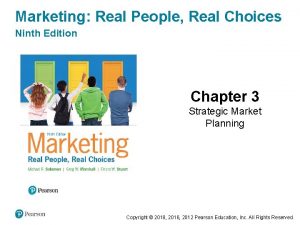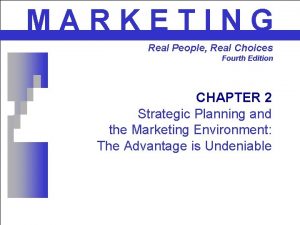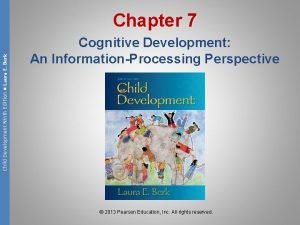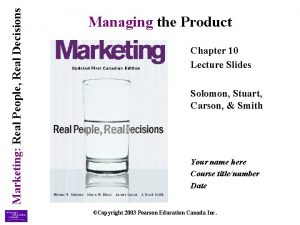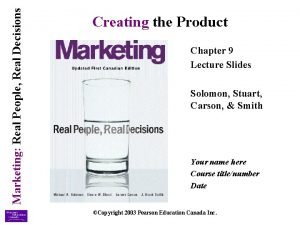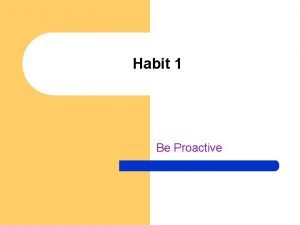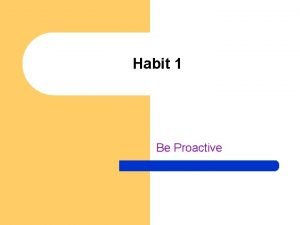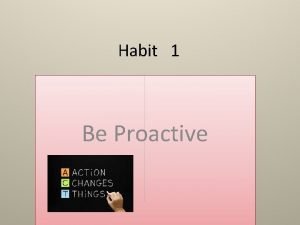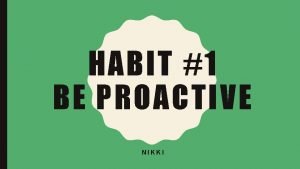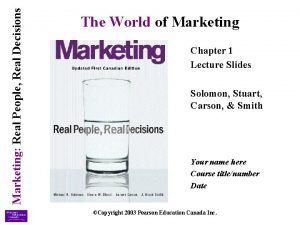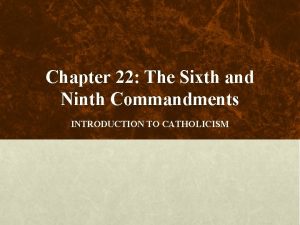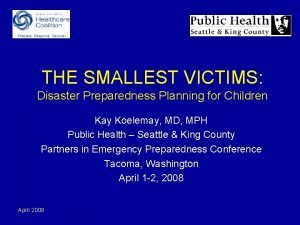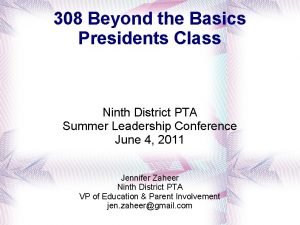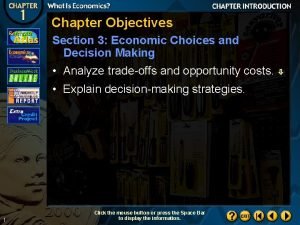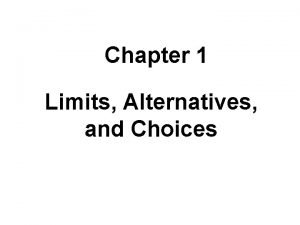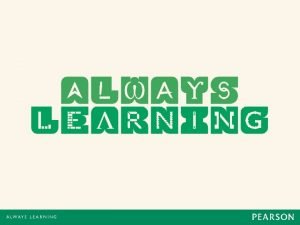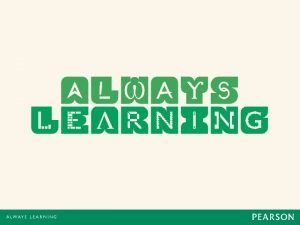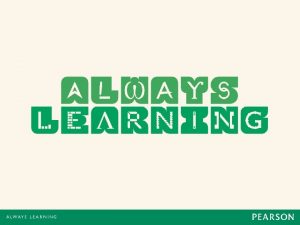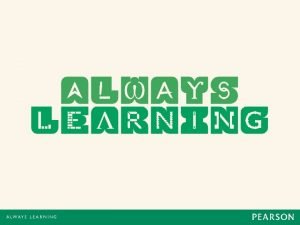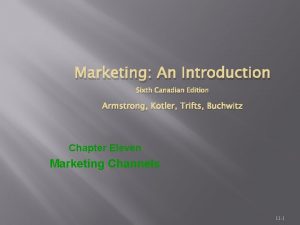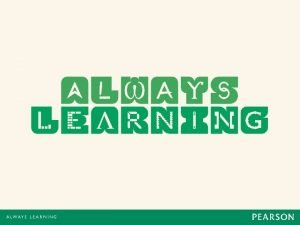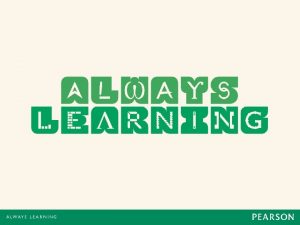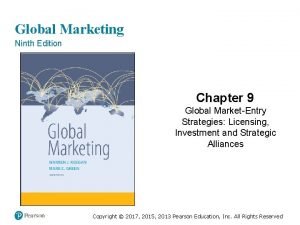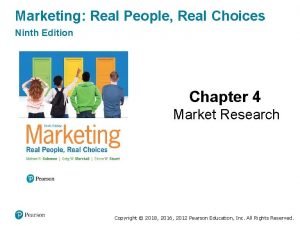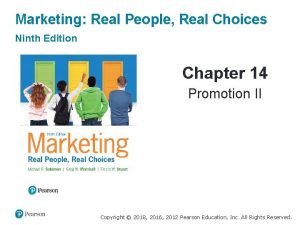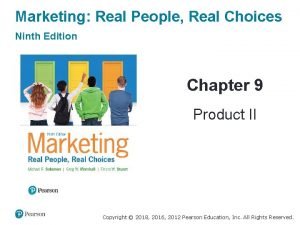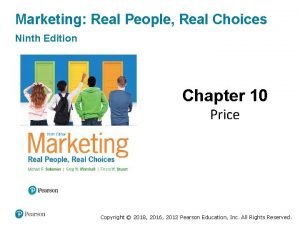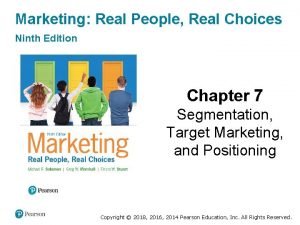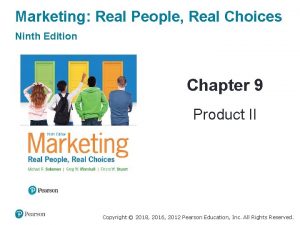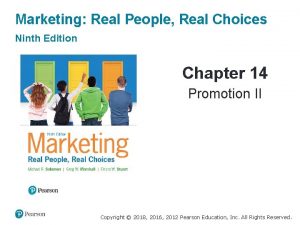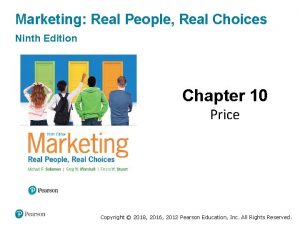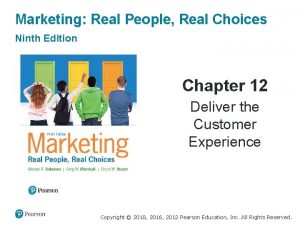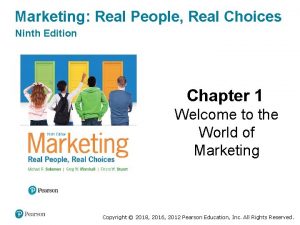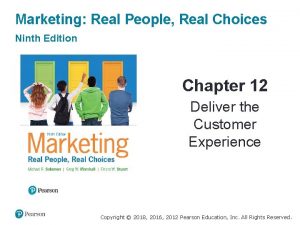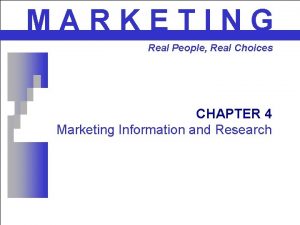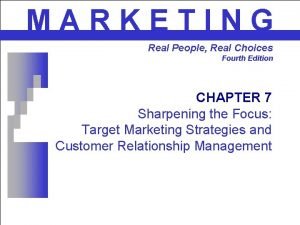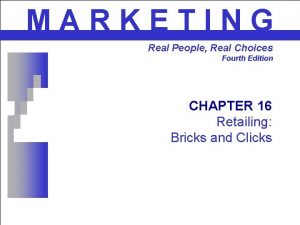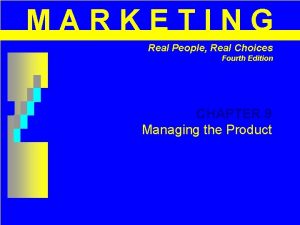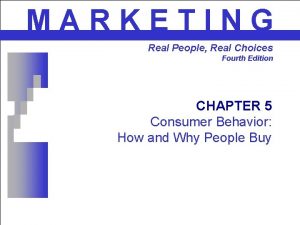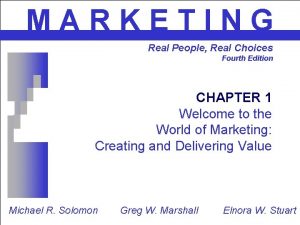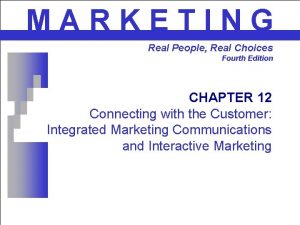Marketing Real People Real Choices Ninth Edition Chapter



















































- Slides: 51

Marketing: Real People, Real Choices Ninth Edition Chapter 2 Global, Ethical and Sustainable Marketing Copyright © 2018, 2016, 2012 Pearson Education, Inc. All Rights Reserved.

Learning Objectives (1 of 2) 2. 1 Understand the big picture of international marketing and the decision firms must make when they consider globalization. 2. 2 Explain how both international organizations, such as the World Trade Organization, economic communities, and individual country regulations facilitate and limit a firm’s opportunities for globalization. 2. 3 Understand how factors in a firm’s external business environment influence marketing strategies and outcomes in both domestic and global markets. Copyright © 2018, 2016, 2012 Pearson Education, Inc. All Rights Reserved.

Learning Objectives (2 of 2 ) 2. 4 Explain some of the strategies and tactics that a firm can use to enter global markets. 2. 5 Understand the importance of ethical marketing practices. 2. 6 Explain the role of sustainability in marketing planning. Copyright © 2018, 2016, 2012 Pearson Education, Inc. All Rights Reserved.

Real People, Real Choices: Decision Time at Johnson & Johnson (1 of 2) Which option should be pursued? § Option 1: A successful tactic from the early roll-out of Earthwards®. § Option 2: Develop a customer intranet site, including an online scorecard to take Earthwards® submissions from an Excel spreadsheet to an online database accessible by all employees. § Option 3: Develop a high-touch strategy of identifying 20 to 30 influential leaders within Johnson & Johnson. Copyright © 2018, 2016, 2012 Pearson Education, Inc. All Rights Reserved.

Marketing on the Global Stage Arguments for a single marketplace § Greenhouse effect § Global warming § Arab Spring Copyright © 2018, 2016, 2012 Pearson Education, Inc. All Rights Reserved.

World Trade World trade refers to the flow of goods and services among different countries. § Not all countries participate equally § Requires flexibility in order to serve needs of remote markets § Countertrade Copyright © 2018, 2016, 2012 Pearson Education, Inc. All Rights Reserved.

Figure 2. 1 North American Merchandise Trade Flows Copyright © 2018, 2016, 2012 Pearson Education, Inc. All Rights Reserved.

Figure 2. 2 Steps in the Decision Process to Enter Global Markets Copyright © 2018, 2016, 2012 Pearson Education, Inc. All Rights Reserved.

Should We Go Global Consider: • Domestic and global market conditions and opportunities • Your competitive advantage Copyright © 2018, 2016, 2012 Pearson Education, Inc. All Rights Reserved.

Consider Your Competitive Advantage • Home-court advantage • Will what made the company successful domestically translate into a new foreign market? Copyright © 2018, 2016, 2012 Pearson Education, Inc. All Rights Reserved.

Understanding the Big Picture of International Marketing In summary: § Marketing decision-making is increasingly influenced by global considerations. § Understanding factors involved with the flow of global trade informs the decision process. Copyright © 2018, 2016, 2012 Pearson Education, Inc. All Rights Reserved.

Initiatives in International Cooperation and Regulation (1 of 2) Initiatives in international regulation and cooperation help trade. § § General Agreement on Tariffs and Trade (GATT) World Trade Organization (WTO) World Bank International Monetary Fund (IMF) Protectionism restricts trade § Quotas, Embargoes, Tariffs Economic communities help to promote trade § NAFTA, EU Copyright © 2018, 2016, 2012 Pearson Education, Inc. All Rights Reserved.

Table 2. 1 Major Economic Communities Around the World Community Andean Community (/www. comunidadandina. org/) Association of Southeast Asian Nations (ASEAN) (/www. aseansec. org/) Central American Common Market (CACM) Common Market for Eastern and Southern Africa (COMESA) (/www. comesa. int/) Member Countries Bolivia, Colombia, Ecuador, Peru European Union (EU) (/www. europa. eu. int/) Austria, Belgium, Bulgaria, Croatia, Cyprus, Czech Republic, Denmark, Estonia, Finland, France, Germany, Greece, Hungary, Ireland, Italy, Latvia, Lithuania, Luxembourg, Malta, Netherlands, Poland, Portugal, Romania, Slovakia, Slovenia, Spain, Sweden (The United Kingdom was a member until it withdrew from the EU in 2016. ) MERCOSUR (/www. mercosur. org/) NAFTA North American Free Trade Agreement (NAFTA) (www. nafta-sec-alena. org) SAPTA South Asian Preferential Trade Arrangement (SAPTA) (/www. saarcsec. org/) Copyright Brazil, Paraguay, Uruguay, Argentina Canada, Mexico, United States Brunei, Cambodia, Indonesia, Lao PDR, Malaysia, Myanmar, Philippines, Singapore, Thailand, Vietnam Costa Rica, El Salvador, Guatemala, Honduras, Nicaragua, Panama Burundi, Comoros, Democratic Republic of Congo, Djibouti, Egypt, Eritrea, Ethiopia, Kenya, Libya, Madagascar, Malawi, Mauritius, Rwanda, Seychelles, Sudan, Swaziland, Uganda, Zambia, Zimbabwe Afghanistan, Bangladesh, Bhutan, India, Maldives, Nepal, Pakistan, Sri Lanka © 2018, 2016, 2012 Pearson Education, Inc. All Rights Reserved.

Analyzing the Marketing Environment Understanding external environment is essential no matter what! When entering foreign markets, knowledge of local conditions is critical. § Helps you to figure out where to go and what strategies are likely to be most effective Copyright © 2018, 2016, 2012 Pearson Education, Inc. All Rights Reserved.

Figure 2. 3 Elements of the Marketing Environment Source: “World Trade Report, ” World Trade Organization, www. wto. org/english/res_e/publications_e/wtr 15_e. htm Copyright © 2018, 2016, 2012 Pearson Education, Inc. All Rights Reserved.

The Economic Environment Marketers need to understand the state of the economy from different perspectives § Overall economic health (e. g. , GDP, Forex Rate) § Current stage of the business cycle Copyright © 2018, 2016, 2012 Pearson Education, Inc. All Rights Reserved.

The Economic Environment: Overall Economic Health Indicators of economic health § Gross Domestic Product (GDP) § Foreign Exchange Rates (Forex) § Economic Infrastructure Copyright © 2018, 2016, 2012 Pearson Education, Inc. All Rights Reserved.

The Economic Environment: Levels of Development Least Developed Country (LDC) § Economic base is often agricultural Developing countries § Economy shifts emphasis from agriculture to industry Developed countries § Offer wide range of opportunities for international marketers Copyright © 2018, 2016, 2012 Pearson Education, Inc. All Rights Reserved.

Bottom of Pyramid Markets Bottom of the Pyramid (BOP) markets present big opportunities and challenges. § 4 billion+ consumers, living on less than $2 daily § $5 billion+ in collective spending power Copyright © 2018, 2016, 2012 Pearson Education, Inc. All Rights Reserved.

The Economic Environment: Business Cycles The business cycle describes the overall pattern of changes or fluctuations in an economy. § Prosperity § Recession § Recovery § Depression Inflation Copyright © 2018, 2016, 2012 Pearson Education, Inc. All Rights Reserved.

The Competitive Microenvironment Competition in the microenvironment involves consumer decision making at three levels. § Competition for discretionary income § Product competition § Brand competition Copyright © 2018, 2016, 2012 Pearson Education, Inc. All Rights Reserved.

The Competitive Macroenvironment Marketers also need to understand the big picture—the overall structure of their industry. § Monopoly § Oligopoly § Monopolistic competition § Perfect competition Copyright © 2018, 2016, 2012 Pearson Education, Inc. All Rights Reserved.

Technological Environment Technology: § Provides firms with important competitive advantages § Profoundly affects marketing activities § Can transform industries Patent: § Legal document giving inventors exclusive rights to produce/sell a particular invention in that country Copyright © 2018, 2016, 2012 Pearson Education, Inc. All Rights Reserved.

Political and Legal Environment Refers to local, state, national, and global laws and regulations that affect business U. S. business laws generally have two purposes § Fair competition § Consumer protection from unfair practices Copyright © 2018, 2016, 2012 Pearson Education, Inc. All Rights Reserved.

Table 2. 3 Significant American Legislation Relevant to Marketers (1 of 2) Law Purpose Sherman Antitrust Act (1890) Developed to eliminate monopolies and to guarantee free competition. Prohibits exclusive territories (if they restrict competition), price fixing, and predatory pricing. Food and Drug Act (1906) Prohibits harmful practices in the production of food and drugs. Federal Trade Commission Act (FTC) (1914) Created the Federal Trade Commission to monitor unfair practices. Robinson-Patman Act (1936) Prohibits price discrimination (offering different prices to competing wholesalers or retailers) unless cost justified. Wheeler-Lea Amendment to the FTC Act (1938) Revised the FTC Act. Makes deceptive and misleading advertising illegal. Lanham Trademark Act (1946) Protects and regulates brand names and trademarks. Child Protection and Toy Safety Act (1969) Sets standards for child-resistant packaging. Copyright © 2018, 2016, 2012 Pearson Education, Inc. All Rights Reserved.

Table 2. 3 Significant American Legislation Relevant to Marketers (2 of 2) Law Purpose Consumer Credit Protection Act (1968) Protects consumers by requiring full disclosure of credit and loan terms and rates. National Do Not Call Registry (2003) Established by the Federal Trade Commission to allow consumers to limit number of telemarketing calls they receive. Credit Card Accountability, Responsibility, and Disclosure Act of 2009 Bans unfair rate increases, prevents unfair fee traps, requires disclosures be in plain language, and protects students and young people. The Affordable Care Act of 2013 Mandates health care coverage for Americans who do not receive benefits through an employer. Revises insurance regulations by eliminating denial of coverage for preexisting conditions, ending lifetime limits on coverage, and so on. 21 Data Broker and Accountability Act of 2014 (DATA Act) Gives consumers access to files of personal information a data broker compiles, the ability to correct inaccuracies, and the chance to opt out of the sale of that data to other companies. USA Freedom Act of 2015 A result of Edward Snowden’s revelations about the National Security Agency’s (NSA) practices regarding collecting and monitoring of phone conversations. Requires that phone metadata be stored by phone companies, not the U. S. government. Copyright © 2018, 2016, 2012 Pearson Education, Inc. All Rights Reserved.

Table 2. 4 U. S. Regulatory Agencies and Responsibilities Regulatory Agency Consumer Product Safety Commission (CPSC) Responsibilities Protects the public from potentially hazardous products. through regulation and testing programs, the CPSC helps firms make sure their products won’t harm customers. Environmental Protection Agency (EPA) Develops and enforces regulations aimed at protecting the environment. Such regulations have a major impact on the materials and processes that manufacturers use in their products and thus on the ability of companies to develop products. Federal Communications Commission (FCC) Regulates telephone, radio, TV and more recently the use of the Internet. FCC regulations directly affect the marketing activities of companies in the communications industries, and have indirect effects on all firms that use these media. Federal Trade Commission (FTC) Enforces laws, primarily through fines, against deceptive advertising and product labelling regulations. Food and Drug Administration (FDA) Enforces laws and regulations on foods, drugs, cosmetics, and veterinary products. FDA approval is required before marketers can introduce many products to the market. Interstate Commerce Commission (ICC) Regulates interstate bus, truck, rail, and water operations and therefore affects the ability of a firm to efficiently move products to its customers. Copyright © 2018, 2016, 2012 Pearson Education, Inc. All Rights Reserved.

Political and Regulatory Constraints on Trade • Political actions of a government may constrain business § Economic Sanctions § Nationalization § Expropriation Copyright © 2018, 2016, 2012 Pearson Education, Inc. All Rights Reserved.

Regulatory Constraints on Trade • Regulatory constraints on trade often restrict the marketing of goods. § Local content rules • Human rights issues may limit foreign countries’ business opportunities. § U. S. Generalized System of Preferences (GSP) Copyright © 2018, 2016, 2012 Pearson Education, Inc. All Rights Reserved.

Sociocultural Environment • Refers to characteristics of a society, its people, and its cultural values and beliefs § Demographics § Cultural Values § Social norms § Language § Consumer Ethnocentrism Copyright © 2018, 2016, 2012 Pearson Education, Inc. All Rights Reserved.

How Global Should a “Global” Marketing Strategy Be? • Hong Kong Disneyland § Bigger is better § Cinderella who? Copyright © 2018, 2016, 2012 Pearson Education, Inc. All Rights Reserved.

Table 2. 5 Market-Entry Strategies (1 of 2) Strategy Exporting Strategy Contractual Agreements Blank Strategic Alliances Direct Investment Level of risk Low Medium Blank Medium High Level of control Low Medium Blank Medium High Options Sell on its own rely on export merchants Licensing License a Franchising A local firm to produce local firm adopts the product your entire business model Joint venture, where Complete firm and local partner ownership often pool their resources buying a local company Copyright © 2018, 2016, 2012 Pearson Education, Inc. All Rights Reserved.

Table 2. 5 Market-Entry Strategies (2 of 2) Strategy Advantages Exporting Strategy Low investment, so presents the lowest risk of financial loss Can control quality of product Avoid difficulties of producing some products in other countries Contractual Agreements Avoid barriers to entry Limit financial investment and thus risk Lose control over how product is produced and May limit marketed, which growth could tarnish opportunities company and brand Disadvantages Perceived as a image Potential “foreign” unauthorized use of product formulas, designs, or other intellectual property Blank Strategic Alliances Direct Investment Local franchisee avoids barriers to entry Limit financial investment and risk Easy access to new markets Preferential treatment by governments and other entities Maximum freedom and control Avoid import restrictions Franchisee may not use the same-quality ingredients or High level of procedures, thus financial risk damaging brand image Highest level of commitment and financial risk Potential for nationalization or expropriation if government is unstable Copyright © 2018, 2016, 2012 Pearson Education, Inc. All Rights Reserved.

Exporting • Should the company sell products on its own or rely on local business partners? • Export merchants are intermediaries a firm uses to represent it in other countries. § Understand local market, know prospective buyers, and may be better able to negotiate terms Copyright © 2018, 2016, 2012 Pearson Education, Inc. All Rights Reserved.

Contractual Agreements • In a licensing agreement, one firm (the licensor) gives another (the licensee) the right to produce and market its product in a specific country. • Franchising is a form of licensing in which the franchisee obtains the right to adopt an entire way of doing business. § Mc. Donalds in India Copyright © 2018, 2016, 2012 Pearson Education, Inc. All Rights Reserved.

Strategic Alliances • Strategic alliances allow companies to pool resources for common goals. § Joint ventures often allow easier access to new markets. Copyright © 2018, 2016, 2012 Pearson Education, Inc. All Rights Reserved.

Direct Investment • Direct investment is when a firm expands internationally through ownership. • Often when it buys a business in the host country outright Copyright © 2018, 2016, 2012 Pearson Education, Inc. All Rights Reserved.

Standardization vs. Localization 1. To what extent will company need to adapt marketing communications to local market? 2. Will the same product appeal to people there? 3. Will it have to be priced differently? 4. How will the company get the product into people’s hands? Copyright © 2018, 2016, 2012 Pearson Education, Inc. All Rights Reserved.

Tweaking the Global Marketing Mix: Product Strategies • Product decisions § Straight extension § Product adaptation § Product invention § Backward invention Copyright © 2018, 2016, 2012 Pearson Education, Inc. All Rights Reserved.

Tweaking the Global Marketing Mix: Price, Promotion, Place Strategies • Promotion decisions • Price decisions § Free trade zones § Gray markets § Dumping • Place/Distribution decisions Copyright © 2018, 2016, 2012 Pearson Education, Inc. All Rights Reserved.

Ethics is Job One in Marketing Planning • Marketing action cannot establish long-term relationships if it is shown to be unethical. § Consequences of low ethical standards can be damaging to firms and managers. § Stockholders may lose investment. § Jobs may be lost. § Confidence in the economy suffers. Copyright © 2018, 2016, 2012 Pearson Education, Inc. All Rights Reserved.

Importance of Ethical Marketing Practices • Business ethics are basic values that guide a firm’s behavior. • § What constitutes ethical behavior is often different for different people. § Ethical philosophies guide how people make such decisions. A code of ethics is a written standard to which everyone in the organization must subscribe. Copyright © 2018, 2016, 2012 Pearson Education, Inc. All Rights Reserved.

Table 2. 6 Some Common Ethical Philosophies Ethical Philosophy Utilitarian approach Rights approach Description of the Ethical Decision The decision that provides the most good or the least harm (i. e. , the best balance of good and harm). The decision that does the best job of protecting the moral rights of all affected. These include the following: • The rights to decide what kind of life to lead • The right to be told the truth • The right not to be injured • The right to privacy Questions for Decision Making Which option will produce the most good and do the least harm? Which option best respects the rights of all who have a stake? Fairness or justice approach The decision that treat all human beings equally— or, if unequally, then fairly based on some standard Which option treats people equally? that is defensible. Common good approach The decision that contributes to the good of all in the community. Virtue approach The decision is in agreement with certain ideal virtues. Honesty, courage, compassion, generosity, Which option leads me to act as the sort tolerance, love, fidelity, integrity, fairness, selfof person I want to be? control, and prudence are all examples of virtues. Which option best serves the community as a whole, not just some members? Copyright © 2018, 2016, 2012 Pearson Education, Inc. All Rights Reserved.

Table 2. 7 AMA Code of Ethics Ethical Norms Ethical Values • Do no harm • Honesty • Foster trust in the marketing system • Responsibility • Embrace ethical values • Fairness • Respect • Transparency • Citizenship Copyright © 2018, 2016, 2012 Pearson Education, Inc. All Rights Reserved.

Is Marketing Unethical? • Marketing serves the rich and exploits the poor. • Products are not safe • Poor quality products • Planned obsolescence • Easy consumer credit makes people buy things they don’t need or can’t afford. Copyright © 2018, 2016, 2012 Pearson Education, Inc. All Rights Reserved.

When is a Bribe Not a Bribe? Ethical Issues for Global Business (1 of 2) • Vast differences in what people around the world consider ethical business behavior § In many LDCs and developing countries, payment in exchange for “favors” is a way of life. § U. S. federal law bans payment to influence decisions by foreign officials to award business contracts. • Bribery occurs when someone voluntarily offers payment to get an illegal advantage. • Extortion occurs when someone in authority extracts payment under duress. Copyright © 2018, 2016, 2012 Pearson Education, Inc. All Rights Reserved.

Sustainability: Marketers Do Well by Doing Good • Many believe sustainability is no longer an option. § Firms must focus on the triple bottom line. § Sustainability is often sensible business. Copyright © 2018, 2016, 2012 Pearson Education, Inc. All Rights Reserved.

Ethical/Sustainable Decisions in the Real World: • Smombie – smartphone zombie • Injuries and deaths are increasing because people walk and text. Should phone companies voluntarily protect phone users from getting hurt while using apps? Copyright © 2018, 2016, 2012 Pearson Education, Inc. All Rights Reserved.

Developing a Sustainable Marketing Mix • Target marketing strategies § Green customers • Product strategies § Fair trade suppliers • Price strategies • Place/Distribution strategies § Locavorism • Promotion strategies Copyright © 2018, 2016, 2012 Pearson Education, Inc. All Rights Reserved.

Sustainable Customer Behavior • A sustainability approach doesn’t end with an improvement in the manufacturing process. • Marketers need to motivate customers. • Consumers can be a part of sustainable marketing practices. Copyright © 2018, 2016, 2012 Pearson Education, Inc. All Rights Reserved.

Copyright © 2018, 2016, 2012 Pearson Education, Inc. All Rights Reserved.
 Slidetodoc.com
Slidetodoc.com Ch 9 ream people real choice case study
Ch 9 ream people real choice case study Marketing real people real choices
Marketing real people real choices Psychology ninth edition in modules
Psychology ninth edition in modules Macroeconomics mankiw 9th edition
Macroeconomics mankiw 9th edition Human anatomy & physiology edition 9
Human anatomy & physiology edition 9 Psychology ninth edition david g myers
Psychology ninth edition david g myers Social psychology ninth edition
Social psychology ninth edition Biology ninth edition
Biology ninth edition Child development ninth edition
Child development ninth edition Child development 9th edition
Child development 9th edition Fundamentals of abnormal psychology ninth edition
Fundamentals of abnormal psychology ninth edition Psychology ninth edition in modules
Psychology ninth edition in modules Psychology ninth edition in modules
Psychology ninth edition in modules Biology ninth edition
Biology ninth edition Campbell ninth edition
Campbell ninth edition Marketing real people real decisions
Marketing real people real decisions Marketing real people real decisions
Marketing real people real decisions Proactive people make choices based on
Proactive people make choices based on Proactive language vs reactive language
Proactive language vs reactive language Habit 1: be proactive examples
Habit 1: be proactive examples Proactive vs reactive worksheet
Proactive vs reactive worksheet Nationalist loyalties examples
Nationalist loyalties examples How do nationalist loyalties shape people's choices
How do nationalist loyalties shape people's choices Marketing real people
Marketing real people 6th and 9th commandments
6th and 9th commandments The sixth and ninth commandments
The sixth and ninth commandments Greek root light
Greek root light What is ramadon
What is ramadon William blount 9th grade academy
William blount 9th grade academy Lower ninth ward
Lower ninth ward 11 course french classical menu ppt
11 course french classical menu ppt Ninth district pta
Ninth district pta Using mis 10th edition
Using mis 10th edition Using mis (10th edition) 10th edition
Using mis (10th edition) 10th edition Lesson 2 making responsible decisions and setting goals
Lesson 2 making responsible decisions and setting goals Lesson 2 our economic choices
Lesson 2 our economic choices Chapter 9 making healthy food choices review answers
Chapter 9 making healthy food choices review answers Chapter 1 how your choices affect income answer key
Chapter 1 how your choices affect income answer key Chapter 1 section 3 economic choices and decision making
Chapter 1 section 3 economic choices and decision making Economizing problem definition
Economizing problem definition Marketing management (arab world edition)
Marketing management (arab world edition) What is the value delivery process
What is the value delivery process Marketing management (arab world edition) philip kotler
Marketing management (arab world edition) philip kotler Keys to effective internal marketing
Keys to effective internal marketing Marketing for hospitality and tourism 7th edition ppt
Marketing for hospitality and tourism 7th edition ppt Marketing an introduction 6th canadian edition
Marketing an introduction 6th canadian edition Tourism and hospitality marketing
Tourism and hospitality marketing Marketing management (arab world edition) philip kotler
Marketing management (arab world edition) philip kotler Marketing management (arab world edition) philip kotler
Marketing management (arab world edition) philip kotler Global marketing 9th edition
Global marketing 9th edition Principles of marketing fifth european edition
Principles of marketing fifth european edition

